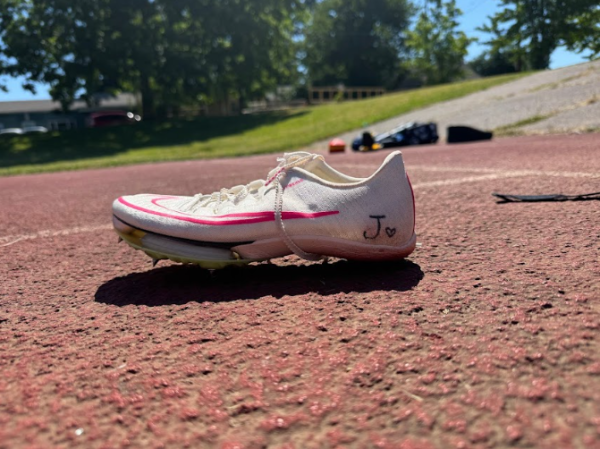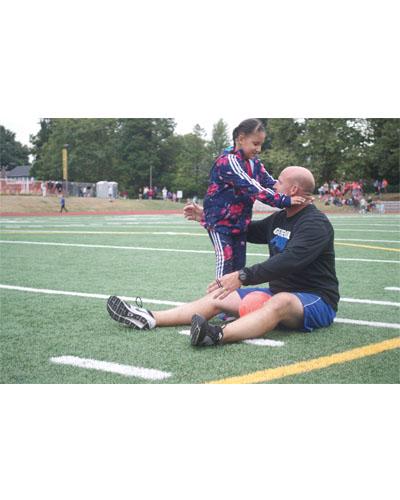Pope Francis, Simone Biles and Grant High Schools’s star athletes all have one thing in common: their use of rituals.
Rituals are defined by the Oxford dictionary as religious or ceremonies made up of a variety of actions performed according to a prescribed order. These tiny acts of repetition can help strengthen bonds within a community.
Rituals are core to the human experience and have been rigorously studied across numerous scientific disciplines. Anthropologists can observe rituals within culture through myths, arts and religion, to name a few. Phycologists study rituals through human behavior, such as emotional regulation and self recognition. Archaeologists take a more physical approach, studying the historical artifacts that were used as part of rituals throughout history.
One of the most prominent ways rituals manifest themself at Grant is through sports. Athletes’ individual steps while they cope with external and internal conflict can shed light on how to use the same techniques outside of athletics.
From religious traditions to making a wish every time the clock reads 11:11, rituals follow the same guidelines. For Grant athletes and alumni, three principles of ritual shine through: use of artifacts, the physical elements; repetition, the symbolic acts that are performed; song and rhythm, which bring everyone together.
Personal items, such as ‘lucky’ objects, can increase confidence in success. The use of physical elements remains present in many cases. Flags and statues are used to symbolize statehood and national unity.
Many people find themselves forming special attachments with objects and tokens. In track and field, you can see athletes turning to their spikes, a shoe designed for sprinting. Scribing initials on the inside of shoes is a common way to turn a simple object into a good luck charm and part of a pre-race ritual.
Looking closely, these little scribbles on the inside of shoes can mean much more to an athlete. Rio Levin, a Grant senior and varsity track athlete, displays an example of this. ‘Mom’ is written on one of his spikes and taps his hand to it before he competes in long jump. “My mom’s been a really important part in staying committed to my track career, so I try to keep her close to competition,” says Levin.
Similarly, Willa Stockton, a Grant junior and varsity track athlete, has her boyfriend’s initials written on the side of her shoe. She says, “He (is always) super supportive when I race … always helps me feel confident right before I race, so that’s why I have his initial on my spike.”
Maddie Crawford, a Grant sophomore and player on the women’s varsity soccer team, made bracelets with Grant’s soccer team showcasing a catchphrase that inspired them: “secure the bread.” Crawford says, “STB started when our coach randomly texted that before one of our games. We thought it was really funny so we kept saying it. It kinda stuck, now before every game we cheer it before kick off. Sometimes during big games or tournaments, we wear it on our wrist.”
Simply showing up makes all the difference when building habits and rituals. Repetition manifests itself in sports as scheduled practices and routines. This constant pattern is beneficial when forming relationships, accountability and trust within groups.
Grant Track and Field coach Julius Shelmire preaches the importance of striving for excellence. He says, speaking on his career as a track and field athlete, “It was so hard for me to stay focused at times… My nerves actually got the best of me a lot.” However, things began to turn around for Shelmire when he was given some important advice. He says, “(Sports psychologists) recommended doing some type of ritual, whether it’s right before you warm up, or right before you get into the blocks. Have routines so your mind can slow down. You can kind of hop in.”

Crawford also finds repetition helpful: “I definitely feel like having a routine is important for me. I feel like it also helps me when I’m nervous before a big game … by doing the same drills for warm-ups makes it feel like (it’s) just soccer and makes me feel better and calmer.”
Ruby Hanson, a Grant junior and varsity tennis player, always taps her racket to the bottom of her shoes, spins it, then taps it on the ground. She says, “I feel like if I don’t do that then I am going to lose the next point so I do it every time I return a serve.”
While attachments to objects and habitual practices are some athletes’ ritual of choice, simply listening to the right music works best for others. Putting on headphones and concentrating helps many athletes build focus. This practice is similar to completing the same warm-up over and over: it provides an outside source to remind your brain that you have done this before.
Stockton and Shelmire both express a need for headphones before a big event. Shelmire says, “I always had to have headphones on. That was a non-negotiable for me. I couldn’t warm up without music in my ears.”
Location can also play an integral part in rituals. In some cases the location itself can even be seen as lucky, in others, it doesn’t seem to matter at all. It simply depends on the person. Lucy Kapranos, a varsity soccer, lacrosse and basketball player at Grant High School, tries to not allow the location of the match affect her mindset. “I try not to think about locations as lucky or unlucky because you don’t have control of where you play, but I do like home games more than away games.”
The pressure of competing in an unfamiliar place also affects professional athletes. Gymnastic Olympian and world champion, Simone Biles, stepped away from the Tokyo 2020 Olympics due in part to atmospheric concerns like bright lights and empty stands. Or, perhaps it was the missing piece of her pre-meet ritual: It was the first major competition in which her mom did not braid her hair.
In large groups, songs and chants can be bonding. Using songs or chants to foster a sense of community can be observed across multiple contexts, whether that be through national anthems, songs of prayer or even songs with educational purposes. Group chanting and singing can help make people feel more included, especially within a team. That’s why at professional levels, music is everywhere, from anthems to harmonized crowd cheers.
The mentality of an athlete can impact their performance significantly. Athletes are often more self-critical than their teammates and coaches, and can have impossible expectations of themselves, leading to negative self-talk.
Varsity tennis player Emma Tadjedin says, “I try to just stay positive and if I’m playing bad, or have a bad shot then I just try to shake it off and move on to the next point. I use this outside of sports because I feel like it’s important to move on from things and not let one thing just drag you down.” It’s important to be able to self-reflect and recognize when negative self-talk begins. Another way to maintain a healthy mindset is practicing mindfulness, which can take many forms, such as meditation, breath work, or guided imagery.
The classic saying, “fake it till you make it,” can be beneficial in convincing yourself that you have a situation under control, which ultimately can help influence your mental state. Creating healthy mindsets can lead to improved physical health and athletic performance. Knowing how to regulate emotions is helpful way beyond the world of sports, too.
Everyone is their own worst critic — humans have that much in common. The difference lies in how people chose to manage this criticism. Through rituals and tools, we can be our own strongest advocate and create success.

































